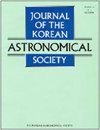中国古代日食中心的观测地点
IF 0.8
4区 物理与天体物理
Q3 ASTRONOMY & ASTROPHYSICS
引用次数: 0
摘要
我们采用Morrison & Stephenson(2004)给出的地球时间与世界时间之差∆T,确定了公元前200年至公元900年中国古代编年史中记录的大星等日食的观测地点。根据中国历代都城的历史变化,大星等日食的记录可分为四组。我们确定每组中所有日食的观测区域,只要日食星等大于某一阈值。我们发现这些区域与历史上的都城重合,这与每个朝代的都城观测日食的一般观点一致。这一结果也验证了公元前100年至公元400年期间的∆T值,在这段时间里,日食的历史记录非常罕见,只能通过插值长期数据来获得∆T值。此外,东亚历史上用“纪”一词描述的日食并不都是日全食;平均星等为0.96±0.04。我们发现互补的表达,如黑暗的白天和日食期间星星的出现,加强了“纪”一词所描述的日食是全食的可能性。我们还提供了诸如“不完整,像钩子一样”、“几乎完整”、“日食期间星星的可见性”和“日食期间的黑暗”等表达的定量定义。这些表达式的字面意思与最近由Können和Hinz(2008)提供的日全食期间天空亮度的物理模型一致。本文章由计算机程序翻译,如有差异,请以英文原文为准。
OBSERVING SITES FOR THE CENTRAL SOLAR ECLIPSES IN ANCIENT CHINESE HISTORY
We determine the observing sites for eclipses of large magnitude recorded in ancient Chinese chronicles from 200 BCE to 900 CE, by adopting the difference between terrestrial time and universal time, ∆T , given by Morrison & Stephenson (2004). The records of solar eclipses with large magnitude are divided into four groups in accordance with the historical variations of the capital cities of ancient Chinese dynasties. We determine areas in which all the eclipses in each group, with an eclipse magnitude larger than a certain threshold value, could be observed. We find that these areas coincide with the historical capitals, which agrees with the general idea that the solar eclipses were observed at the capital of each dynasty. This result also verifies the ∆T values during the period from 100 BCE to 400 CE, during which historical records of eclipses are so rare that the ∆T values can only be obtained by interpolating the long-term data. Moreover, we show that the eclipses described by the term Ji in East-Asian history are not all total eclipses; their mean magnitude is 0.96± 0.04. We find that complementary expressions, such as dark daytime and appearance of stars during the eclipse, strengthen the possibility that eclipses described by the term Ji were total. We also provide quantitative definitions for expressions such as ‘being not complete and like a hook’, ‘being almost complete’, ‘visibility of stars during the eclipse’, and ‘darkness during an eclipse.’ The literal meanings of these expressions are in agreement with the recent physical modeling of sky brightness during total eclipses provided by Können & Hinz (2008).
求助全文
通过发布文献求助,成功后即可免费获取论文全文。
去求助
来源期刊

Journal of the Korean Astronomical Society
地学天文-天文与天体物理
CiteScore
1.30
自引率
10.00%
发文量
0
审稿时长
>12 weeks
期刊介绍:
JKAS is an international scientific journal publishing papers in all fields of astronomy and astrophysics. All manuscripts are subject to the scrutiny of referees. Manuscripts submitted to JKAS must comply with the ethics policy of JKAS. Six regular issues are published each year on February 28, April 30, June 30, August 31, October 31, and December 31. One year''s issues compose one volume.
 求助内容:
求助内容: 应助结果提醒方式:
应助结果提醒方式:


